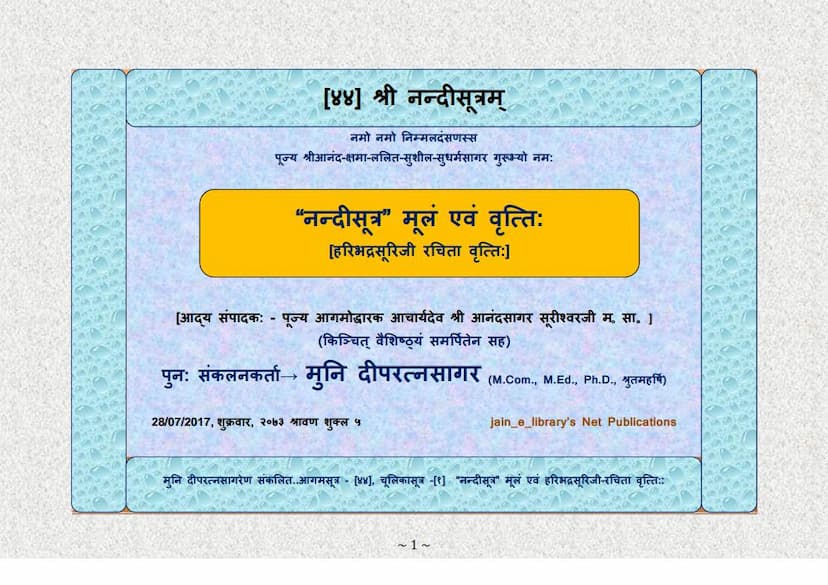Aagam 44 Nandisootra Haaribhadriyaa Vrutti
Added to library: September 1, 2025

Summary
Here's a comprehensive summary of the Jain text "Aagam 44 Nandisootra Haaribhadriyaa Vrutti" based on the provided pages:
Book Title: Aagam 44 Nandisootra Haaribhadriyaa Vrutti Author(s): Dipratnasagar, Deepratnasagar Publisher: Deepratnasagar Original Commentator: Haribhadra Suri Ji Chief Editor of the Edition: Pujya Agamoddharak Acharya Shri Anandasagar Surishwarji M. Sa. Compiler: Muni Diperatnasagar (M.Com., M.Ed., Ph.D., Shrutmaharshi) Publication Date: July 28, 2017
Overall Nature of the Text:
This is a Jain text, specifically the "Nandi Sutra," presented with the commentary ("Vrutti") composed by the esteemed Jain scholar Haribhadra Suri Ji. The publication is a compilation by Muni Diperatnasagar, making this ancient commentary accessible in a modern format. The text delves into the foundational principles of Jainism, with a particular focus on knowledge and the path to liberation.
Key Contents and Themes:
-
Nandi Sutra and Haribhadra's Commentary: The core of the text is the Nandi Sutra, a significant scripture within the Jain Agamas. The extensive commentary by Haribhadra Suri Ji provides detailed explanations, interpretations, and philosophical elaborations on the sutras.
-
Purpose and Structure: The compiler, Muni Diperatnasagar, explains his motivation for re-compiling this work, aiming to honor the legacy of Acharya Anandasagar Surishwarji and make the teachings widely available. The publication is presented in a user-friendly format with clear indexing and cross-referencing.
-
Invocation and Salutation: The text begins with prayers and salutations to the pure vision (Nirmal Darshan) and respected Gurus, establishing a devotional and reverential tone.
-
Content Overview (Index): The index reveals the wide-ranging topics covered in the Nandi Sutra and its commentary, including:
- Praise of Lord Mahavir.
- Praise of the Sangha (Jain community).
- Veneration of Jin (Tirthankaras).
- Genealogy of Spiritual Preceptors (Sthaviravali).
- Description of the audience (Shrōta, Parshad).
- Classification and description of different types of knowledge (Mati, Shrut, Avadhi, Manahparyaya, Kevala Gyana).
- Detailed explanations of various concepts, including the etymology of the word "Nandi."
- The concept of "Nandi" itself is presented as having four types: Nam Nandi, Sthapana Nandi, Dravya Nandi, and Bhava Nandi.
- Discussions on auspicious beginnings (Mangala) and the importance of invoking the Tirthankaras.
- Detailed analysis of the different types of knowledge (Mati, Shrut, Avadhi, Manahparyaya, Kevala) and their characteristics, including their acquisition and scope.
- The text includes extensive hymns and praises dedicated to the Tirthankaras and the Sangha, employing various metaphors and allegories.
- Detailed explanations of the structure and contents of the Jain Agamas, including the twelve Angas and fourteen Purvas.
- Discussions on the classification of scriptures (Agam) and the significance of different types of knowledge for the path to liberation.
-
Philosophical Depth: Haribhadra Suri Ji's commentary is known for its analytical rigor and deep philosophical insights. The text engages with subtle distinctions in knowledge, the nature of reality, and the ethical conduct required for spiritual progress.
-
Compilation and Accessibility: Muni Diperatnasagar's effort is to present this valuable Jain literature through jain_e_library.org for wider dissemination, with a plan for future print publications. The digital format aims to reach a global audience efficiently.
Specific Topics Discussed (as indicated by the index and sample pages):
- Types of Knowledge: The text meticulously details the five types of knowledge:
- Mati Gyana (Sensory Knowledge): Acquired through senses and mind, further classified into various types like Avagraha, Eeha, Apay, and Dharana.
- Shrut Gyana (Scriptural Knowledge): Acquired through scriptures and teachings.
- Avadhi Gyana (Limited Clairvoyance): Knowledge of subtle matter within a limited range.
- Manahparyaya Gyana (Mind-reading Knowledge): Knowledge of the thoughts of others.
- Keval Gyana (Omniscience): Absolute and complete knowledge.
- The Concept of "Nandi": The word "Nandi" is analyzed etymologically and philosophically, signifying joy, prosperity, and a means to achieve auspiciousness.
- Praise of Tirthankaras and the Sangha: The initial sections are dedicated to praising the Tirthankaras and the Jain Sangha, setting a virtuous foundation for the discourse.
- Gana-dharavali and Sthaviravali: The text may include lineages of spiritual leaders, tracing the transmission of Jain knowledge through generations.
- Various Metaphors and Allegories: The commentary uses rich imagery and metaphors to explain complex philosophical concepts, likening the Sangha to a city, a chariot, a lotus, the sun, and the ocean.
- Importance of Right Faith (Samyak Darshan), Right Knowledge (Samyak Gyana), and Right Conduct (Samyak Charitra): These are implicitly or explicitly highlighted as the pillars of the Jain path.
- The Nature of the Soul and Karma: While not explicitly detailed in the provided snippets, the discussion on knowledge inherently touches upon the soul's capacity to know and the karmic obstructions that limit it.
Significance of the Publication:
This edition by Muni Diperatnasagar is significant for its scholarly compilation and accessibility. It preserves and disseminates the profound wisdom of Haribhadra Suri Ji's commentary on the Nandi Sutra, a key text for understanding Jain epistemology and spiritual practice. The focus on clarity and the availability through "jain_e_library's" Net Publications makes this valuable work accessible to a wider audience interested in Jain philosophy and scriptures.